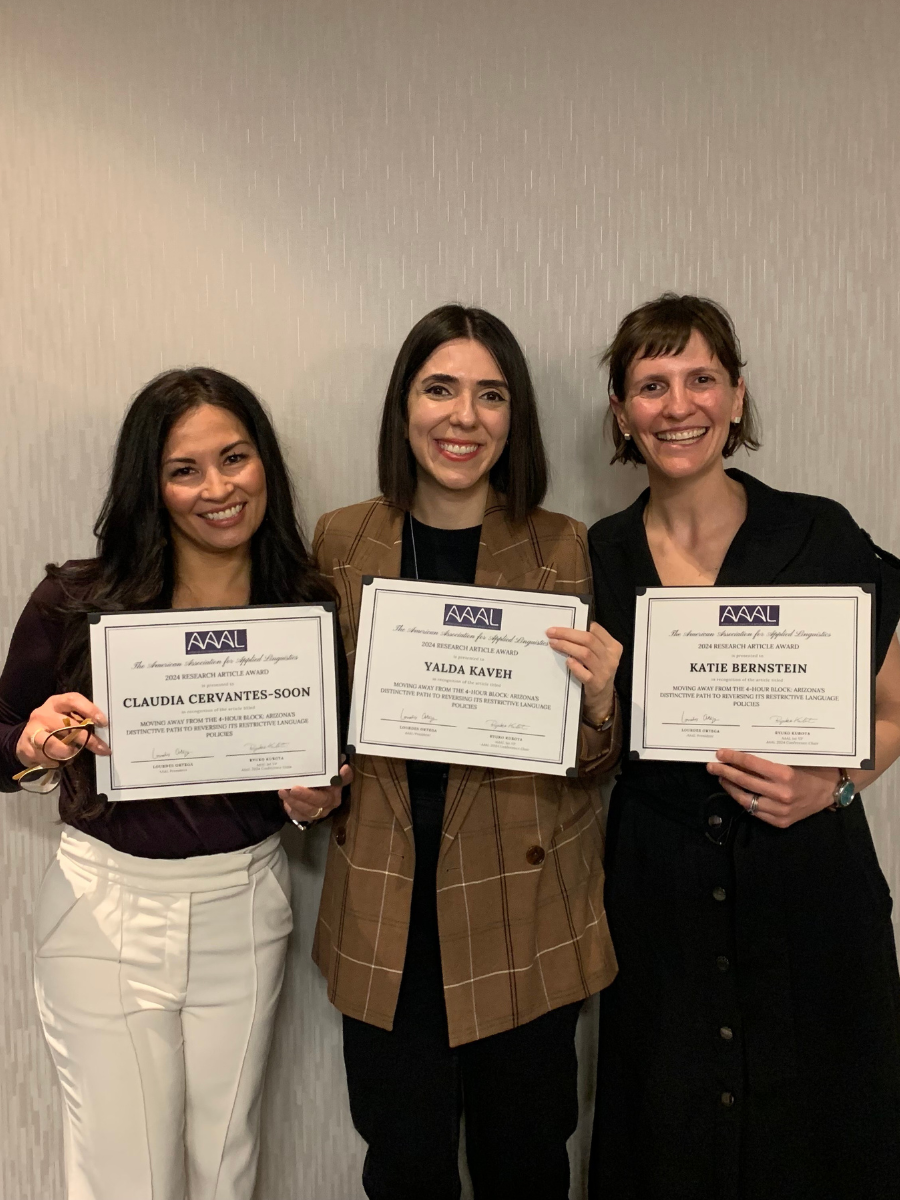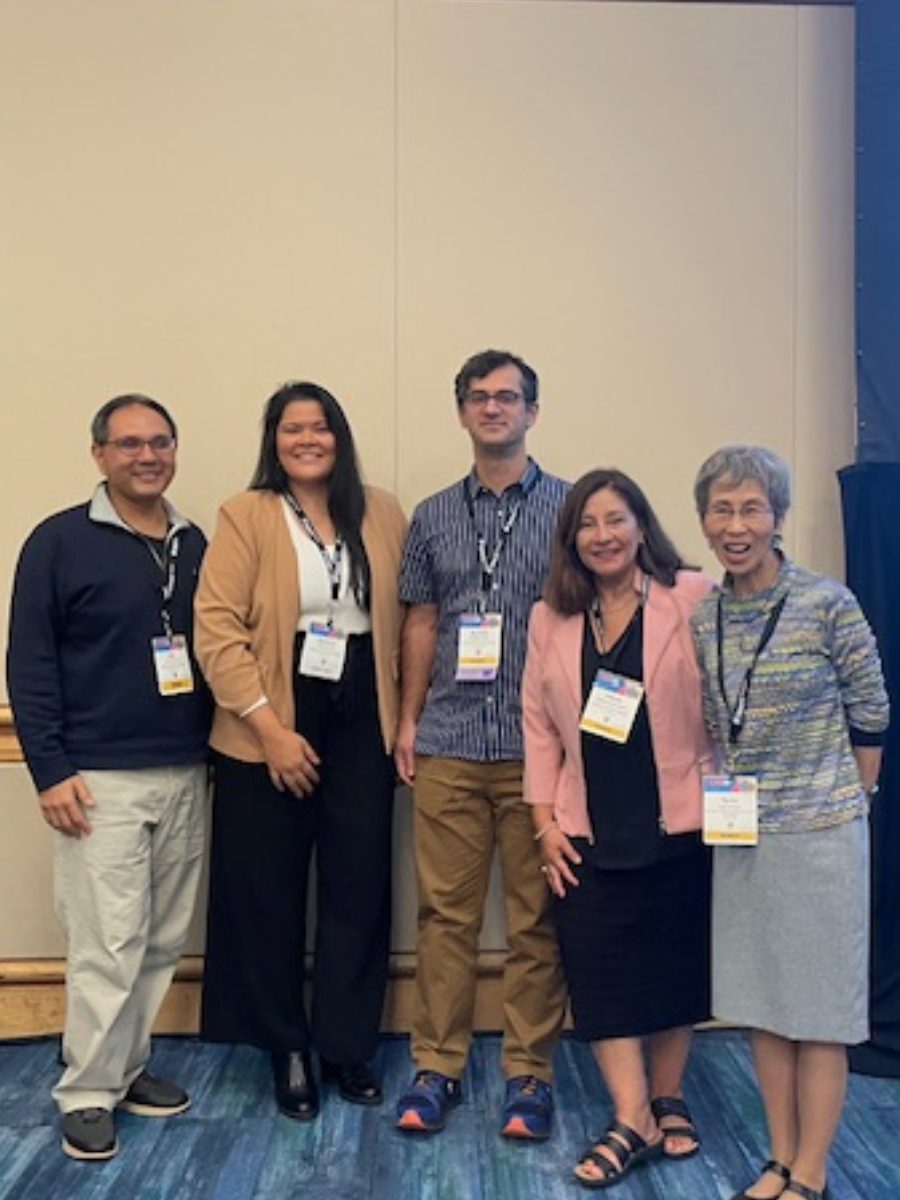Feature Articles
June 2024 AAALetter
June 2024 AAALetter
Table of Contents
- Rethinking the Boundaries of Language, Rethinking the Boundaries of Applied Linguistics | Jerry Won Lee
- Using Critical Discourse Analysis to Advocate for More Just Language Policies | Katie A. Bernstein, Yalda M. Kaveh, & Claudia Cervantes-Soon
- Teacher Candidates’ Negotiation of Raciolinguistic Ideologies | Christian Fallas Escobar
- AAAL at TESOL 2024: Sharing Insights into our Advocacy Efforts | Peter De Costa
Rethinking the Boundaries of Language, Rethinking the Boundaries of Applied Linguistics
Jerry Won Lee, University of California, Irvine
2024 AAAL Book Award Recipient

Korea, under construction
My book, Locating Translingualism, makes the argument that languages and cultures do not exist unto themselves but can be momentarily seen in moments of encounter with other languages and cultures. My treatment of translingualism does not purport to be entirely new; it is presented as an orientation to language that recognizes the resourceful fluidity of conventional boundaries and that is attentive to the wide range of “nonlinguistic” factors that shape communication, including semiotic resources and spatial elements.
However, while translingualism as a theory of language has been a productive way to understand the complexities of intercultural communication, what does culture look like, prior to the inter? It is important to note that the title of the book is meant to be a double entendre. It represents, on the one hand, a call to pay careful attention to emergent forms of communicative action in diverse contexts: to locate instances of translingualism. It also represents, on the other hand, the possibility of translingualism as a theoretical lens through which to identify instances of linguistic and cultural particularities: translingualism as the agent doing the locating.
In writing this book, I was hoping to make a series of offerings to the field of applied linguistics. In terms of theory, I present the idea of “semiotic precarity,” which I define as a condition “when the presumed essence of an entity is unable to be taken for granted (whether by an ‘outsider’ or even an ‘insider’) and therefore demands affirmation or reaffirmation via semiotic distinction” (p. 21). I make the claim that there can be no Korean restaurants in Korea, since a Korean restaurant in Korea is just a restaurant. If this is the case, when we encounter a “Korean restaurant,” what kind of semiotic work is being done to make it “Korean”? I also introduce a few other concepts, including “translingual inversion,” “semiotic excess,” and others. I hope these ideas turn out to be useful to other scholars, especially those interested in language and communication in intercultural contexts.
Through my work, I hope we can also continue to work together to rethink and expand what “applied linguistics” is in the first place. I fully acknowledge that “How is this applied linguistics?” is probably a question many readers will ask if they read my book. After all, many people continue to associate the field with work related to language acquisition and language teaching ONLY. But it’s obviously not limited to that. According to the AAAL, “Applied Linguistics addresses a broad range of real-life language-related issues by developing its own knowledge-base about language, its users and uses, and their underlying social and material conditions.” In order to achieve this goal, we need to think more actively and expansively about the various sites where language happens and is encountered. The objects that I draw on—some more unusual than others—provide a glimpse into how my strange mind works: multilingual restaurant signage to territorial dispute discourses and cereal boxes to warning signs in public toilets.
If anything, I hope my book inspires other researchers in the field to consider a wider range of objects, sites, and phenomena where languaging occurs, even and especially those that seem, at first glance, to have absolutely nothing to do with applied linguistics—because they actually just might.
Using Critical Discourse Analysis to Advocate for More Just Language Policies
Katie A. Bernstein, Yalda M. Kaveh, and Claudia Cervantes-Soon, Arizona State University
2024 AAAL Research Article Award Recipients

Drs. Claudia Cervantes-Soon, Yalda Kaveh, and Katie Bernstein
(from left to right) at the 2024 AAAL conference,
smiling and holding their Best Research Article Awards
Pop quiz: What do Arizona, California, and Massachusetts have in common?
This might seem like a trick question, but anyone who studies U.S. language education policies knows the answer: Arizona, California, and Massachusetts are the three U.S. states that passed strict “English-only” education policies back in 1999–2002. These policies meant that students who weren’t yet proficient in English (“English language learners” or as we prefer, “emergent bilinguals”) could not participate in bilingual education in those states.
Of the three states’ laws, Arizona’s was the strictest. Rather than just keeping emergent bilinguals out of bilingual programs, it also required them to spend four hours a day in special Structured English Immersion (SEI) classrooms, away from English-speaking students. This policy, known locally as the “four-hour block,” did not go well for students. Emergent bilinguals experienced segregation, missing out on content classes, low graduation rates, emotional distress, and missed opportunities to develop strong bilingual identities and strong bilingual and biliteracy skills (see, among many, Gándara & Orfield, 2012; Lillie et al., 2012; Lillie, 2016).
The laws in all three states remained in place until 2016, when California announced that a repeal measure would be put on the November ballot. Immediately, we (Katie, and my friend and co-author, Noah Katznelson) decided to examine the text of the proposition (Prop 58) using critical discourse analysis (CDA), an approach to understanding how texts reflect and reproduce larger societal discourses. We quickly noticed two things: (1) the bill wasn’t about emergent bilinguals having access to bilingual education; (2) instead, it was about all students having access to multilingual education so that they—and California—could succeed in the global economy. The policy authors had skillfully tapped into dominant societal narratives, or discourses, around globalization, the economy, and the need for skilled workers, in order to persuade California voters. We wrote an article (Katznelson & Bernstein, 2017) before the November election, using evidence from our critical discourse analysis to predict that the bill would easily pass. And it did: the repeal bill passed 75% to 25%. Remarkably, more than a million people who voted for Donald Trump also voted for multilingual education.
In the case of California, CDA provided a lens to make predictions about whether legislation would pass. In Massachusetts, a similar repeal passed in 2017, and others (Rubio, 2022) used CDA to understand the ideologies that gave way to its passing. In our own state, Arizona, CDA has also helped us understand language policy changes.
In 2019, Arizona saw some movement on its restrictive policy as well. That year, a seemingly small piece of legislation, House Bill 1014, reduced the four-hour SEI block for emergent bilinguals down to two hours. Critically, the state superintendent and state board of education then determined that those two hours could be met in a 50-50 dual language program (where students learn for half of the school day in English and the other half in a partner language, like Spanish). Suddenly, English language learners in Arizona were permitted in bilingual programs again, for the first time in 20 years.
Scratching our heads in delighted surprise, we (Katie, Claudia, and Yalda, along with two PhD students, Sara Rodríguez Martínez and Saida Mohammed) asked ourselves: how did this bill pass so easily? Turning to the tools of CDA, we examined the testimonies from the Senate and House hearings about the bill to understand the strategies that led to its success (Kaveh et al., 2022).
We found three patterns. First, all of the speakers used a strategy we called “damage convergence” (after Bell’s [1980] theory of “interest convergence”): showing how everyone was harmed by the four-hour English block. For instance, speakers argued that emergent bilingual students experienced segregation, schools had scheduling and staffing problems, and even the state of Arizona spent a lot of money for little impact. Secondly, all the speakers also showed how the new bill would fix these issues and therefore benefit everyone. Finally, and perhaps most importantly, the speakers explained how the bill, by putting decisions back into the hands of parents and schools, aligned with two core Arizona values—choice and local control.
Together, these findings helped us explain the success of the bill (and our work—Kaveh et al. [2022]—won the 2024 AAAL Research Article Award!). But most importantly, our findings provided us with a roadmap for advocacy and future legislative change in Arizona, showing us how consensus could be built across party lines by drawing on local discourses, such as narratives of importance of choice and local control.
Unfortunately, in 2022, Arizona elected a new state superintendent, Tom Horne, a proponent of English-only, who has reversed course and has returned to strict enforcement of the English-only policy. We (Katie, Claudia, and Yalda, and three PhD students, Lindsey Brown, Brandon Yuhas, and Sepide Pazhouhi) have again turned to CDA for help. This time, CDA has helped us understand the superintendent’s argumentation strategies in order to better counter them and to help chart a path forward (Bernstein et al., 2024). We are also using the discursive roadmap from our 2022 analysis to help local advocacy organizations work on repeal legislation.
Fairclough (2003, 2013) was adamant that CDA should never stop at explaining or even critiquing. Instead, CDA is meant to be a tool for action to counter injustice. In Arizona, CDA is helping us to understand, critique, AND combat unjust language policies.
References
Bell, D. A., Jr. (1980). Brown v. Board of education and the interest-convergence dilemma. Harvard Law Review, 93(3), 518–533. https://doi.org/10.2307/1340546
Bernstein, B., Brown, L., Kaveh, Y. M., Yuhas, B., Pazhouhi, S., Cervantes-Soon, C. (2024, March). The perils of relying on benevolent policy arbiters: Arizona’s return to 2000s-era English-only enforcement. AAAL Conference, Houston, TX.
Fairclough, N. (2003). Analysing discourse: Textual analysis for social research. Routledge.
Fairclough, N. (2013). Critical discourse analysis: The critical study of language. Routledge.
Gándara, P., & Orfield, G. (2012). Why Arizona matters: The historical, legal, and political contexts of Arizona’s instructional policies and US linguistic hegemony. Language Policy, 11(1), 7–19. https://doi.org/10.1007/s10993-011-9227-2
Katznelson, N., & Bernstein, K. A. (2017). Rebranding bilingualism: The shifting discourses of language education policy in California’s 2016 election. Linguistics and Education, 40, 11–26. https://doi.org/10.1016/j.linged.2017.05.002
Kaveh, Y. M., Bernstein, K. A., Cervantes-Soon, C., Rodriguez-Martinez, S., & Mohamed, S. (2022). Moving away from the 4-hour block: Arizona’s distinctive path to reversing its restrictive language policies. International Multilingual Research Journal, 16(2), 113–135. https://doi.org/10.1080/19313152.2021.1973261
Lillie, K. E. (2016). The lost generation: Students of Arizona’s structured English immersion. International Journal of Bilingual Education and Bilingualism, 19(4), 408–425. https://doi.org/10.1080/13670050.2015.1006162
Lillie, K. E., Markos, A., Arias, M. B., & Wiley, T. G. (2012). Separate and not equal: The implementation of structured English immersion in Arizona’s classrooms. Teachers College Record, 114(9), 1–33.
Rubio, J. (2022). Educational language policy in Massachusetts: Discourses of the LOOK Act. Educational Policy, 36(6), 1440–1463.
Teacher Candidates’ Negotiation of Raciolinguistic Ideologies
Christian Fallas Escobar, Universidad Nacional, Costa Rica
2024 AAAL Dissertation Award Recipient
In U.S. schools, the language practices of Latinas/os are construed as deficient regardless of actual proficiency, revealing the practice of evaluating their dexterity through racial logics or raciolinguistic ideologies (Rosa & Flores 2017). Conversely, U.S.

2024 AAAL Dissertation Award recipient
Latinas/os face pressure to learn “standard” Spanish, seen as key to the maintenance of their cultural heritage. Further, codeswitching is associated with incomplete proficiency. U.S. Latinas/os who choose to major in bilingual education start their programs having been caught in the crossfire. Motivated by the above, I conducted a critical ethnography with 17 Latina/o bilingual teacher candidates (TCs) completing their teacher education, guided by the question: How do Latina/o bilingual TCs negotiate circulating raciolinguistic ideologies?
I drew on Rosa’s and Flores’ (2017) raciolinguistic perspective to examine the conflation of racialized bodies with linguistic deficiency. To capture the emergence of raciolinguistic ideologies, I drew on Rymes’ (2014) concept of metacommentary: explicit or implicit verbal comments or body comportments that draw attention to linguistic or nonlinguistic features of speakers’ communicative repertoires. I extended the concept by specifying that these ideological comments mobilize stereotypical images of racialized individuals while reinscribing existing racial hierarchies, which I termed “raciolinguistic metacommentary.” Finally, with an eye to resistance, I drew on Stroud’s and Kerfoot’s (2021) concept of linguistic citizenship (LC), defined as “acts of language . . . performed outside of the institutional status quo, that engage with voices on the margins to create conditions for transformative agency” (p. 10).
I conducted this study at a large public Hispanic-serving institution in Southwest Texas (Metro) with a student body of almost 60% identifying as Hispanic. Recruited TCs were enrolled in the class “Language Development in Bilinguals,” which introduced them to factors affecting language development in schools and communities. Out of 29 bilingual TCs taking this class, 17 participated in my study. I conducted participant observation and individual interviews and collected classroom artifacts. Also, I conducted follow-up individual interviews and group member-checking with 9 participants. Open coding of these data resulted in over 50 codes, which I categorized into themes via the constructs of raciolinguistic metacommentary and linguistic citizenship. I re-coded all existing data using this coding scheme.
Raciolinguistic metacommentary across spaces
Analysis showed TCs have encountered raciolinguistic metacommentary across spaces. To illustrate, Lisa was born and raised in Piedras Negras, where she and her siblings attended a bilingual school. Later, Lisa’s parents sent them to complete their education in Eagle Pass, the United States, where they would have better educational opportunities. Yet, Lisa’s parents also wanted them to learn Spanish “well,” with which they thought to help by enforcing a no-Spanglish policy at home. In fact, policing for Spanglish became such a common practice that even Lisa’s sister engaged in it. Lisa narrated always being on alert about how she uses language because, if she code switches, her family tells her: “ay ahora te estás haciendo gringa [oh, now you are turning into a gringa].”
Just like Lisa, other TCs described experiencing raciolinguistic metacommentary. For instance, within the home, TCs encountered raciolinguistic metacommentary that outlaws English and Spanglish (“Aquí se habla español!”), circulates notions of Latina/o Spanish as more legitimate than U.S. Spanish (“No lo dices así!”), and construes English and Spanglish as incompatible with Latina/o authenticity (“Ay, ahora te estás haciendo gringa?”). Within schools, they have witnessed raciolinguistic metacommentary that frames English monolingualism as evidence of academic readiness (“Repeat after me!”).
At work, TCs have confronted raciolinguistic metacommentary that depicts Caribbean and U.S. Spanish as inferior to Castilian Spanish and advances the idea that linguistic dexterity in English is an unusual feature of Latinas/os (“If I were to close my eyes, I would think that you're just from the Midwest and…that Spanish is not your first language”). Finally, in social and public spaces, TCs have received raciolinguistic metacommentary that reinscribes the notion that English is the language of the United States (“Speak English, you’re in America!”) and that Latinas/os are under the obligation of showing allegiance to the United States via the learning of English.
Racialized notions and identities
Analysis also showed that raciolinguistic metacommentary not only indexes linguistic difference but also mobilizes indexical images of Latina/o bilinguals while reinscribing existing racial hierarchies. For instance, raciolinguistic metacommentary that TCs articulated themselves reproduces problematic notions of language, such as the following: (1) Spanish as a language to be contained in U.S. institutions, (2) Spanglish as a disease or a bad habit to be avoided, and (3) English as the language of professionalism, success, and school readiness. These notions were evident in, for instance, TCs’ use of "se me sale [it slips out]” to characterize their use of Spanish, and their employment of “se me pega [accidentally pick up]” to justify their use of Spanglish.
Furthermore, analysis demonstrated that raciolinguistic metacommentary advances marginalizing social stereotypes, such as the following: (1) pochas/os and gringas/os, or Latinas/os who cannot speak Spanish properly, are therefore not authentically Latina/o Mexican; (2) fresas are snobs who aspire to pass for upper-middle class, as evidenced by their mixing of English and Spanish, and (3) English language learners/Spanish speakers are academically unprepared and/or unintelligent. These notions of language and indexical images have shaped how TCs embody language and resulted in experiences of linguistic insecurity/shame, language shift/loss, and hyper vigilance toward linguistic correctness.
Alternative notions and identities
Finally, despite the barrage of raciolinguistic metacommentary, TCs have leveraged what they have learned from their teacher preparation program and from members of the Latina/o community to challenge the sociolinguistic status quo. For instance, they have started to embrace their linguistic hybridity across spaces regardless of others’ reactions. In addition, they have formulated alternative notions of language, such as bilingualism as fingerprint, bilingualism for the family, and bilingualism to help others. These alternative notions of bilingualism have allowed Latina/o TCs to reframe their U.S. Spanish as cultural legacy and their efforts at maintaining it as critical cultural work.
My analysis also unveiled that TCs have also envisioned alternative identities, such as Tejano or linguistic and cultural hybrids, empowered pochas Chicanas, and fluid bilinguals. These alternative subject positions construe linguistic and cultural hybridity as the norm and problematize the linguistic/ethnic boundaries that the stereotypes of pocha/o, gringa/o, fresas, and English language learners bring about. These alternative identities challenge existing ideologies that attribute brokenness and ethnic inauthenticity to U.S. Latinas/os.
Implications
These findings have several implications. First, the home/community were vital spaces where TCs first experienced linguistic policing. Therefore, they merit critical attention as places of contention. Second, current bilingual teacher education models do not address the affective domain. TCs are preparing to become effective bilingual teachers while still grappling with raciolinguistic ideologies. Therefore, effective bilingual teacher education should consider emotion as a critical aspect of TCs’ identity negotiation. Third, TCs were able to articulate alternative notions and identities, which should be leveraged within teacher education programs. Research that does not magnify these agentive stances may miss a rich opportunity to envision collective agency. Lastly, raciolinguistic ideologies are difficult to sight/site, since they can be overtly articulated. Against this backdrop, raciolinguistic metacommentary promises to be a useful tool to examine structures of racial inequity and marginalization, particularly regarding how raciolinguistic ideologies emerge in Latina/o bilingual TCs’ everyday lives.
References
Rosa, J., & Flores, N. (2017). Unsettling race and language: Toward a raciolinguistic perspective. Language in Society, 46(5), 621–647. https://doi.org/10.1017/S0047404517000562
Rymes, B. (2014). Communicating beyond language: Repertoire and metacommentary as methods. In B. Rymes (Ed.), Communicating beyond language: Everyday encounters with diversity (pp. 126–133). Routledge. https://doi.org/10.4324/9780203129616
Stroud, C., & Kerfoot, C. (2021). Decolonizing higher education: Multilingualism, linguistic citizenship and epistemic justice. In Z. Bock & C. Stroud (Eds.), Language and decoloniality in higher education: Reclaiming voices from the South (pp. 19–46). Bloomsbury.
AAAL at TESOL 2024: Sharing Insights into our Advocacy Efforts
Peter De Costa, Michigan State University
AAAL President

(from left to right): Drs. Peter De Costa,
Stephanie Link, Bedrettin Yazan,
Fabiola P. Ehlers-Zavala, and Ryuko Kubota
Last August, Jeff Hutcheson, the Advocacy & Public Policy Director of TESOL International Association, kindly extended an invitation to AAAL to present at the 2024 TESOL International Convention & Expo. The invited presentation was to be part of a series of advocacy-focused sessions that covered key topics such as “Why Every Teacher Should Care About the Seal of Biliteracy” and “Advocacy 101: Impact Policy at Local, State, and National Levels.” Given AAAL’s longstanding close relationship with TESOL and our common commitment to diversity, equity, inclusion, and access (see TESOL’s white paper on discrimination in education), I gratefully accepted the generous invitation and subsequently assembled a panel of AAAL colleagues who are also longstanding TESOL members. Our 75-minute panel, which took place on March 22, 2024 in Tampa, Florida, included Fabiola P. Ehlers-Zavala (former AAAL President, 2022–2023), Ryuko Kubota (President Elect), Bedrettin Yazan (immediate past PAEC Chair), Stephanie Link (immediate past OEOC Chair), and me. The goal of the panel was to inform the audience about the advocacy work that AAAL has undertaken in recent years.
The session started with my briefly introducing our organization to the audience and emphasizing the collaborative ties that AAAL has with other external boards and associations, including the Joint National Committee for Languages (AAAL’s representative on this committee is Amelia Tseng from American University). Fabiola P. Ehlers-Zavala, who also served as the AAALetter Editor and Secretary before becoming President, provided a brief historical account of AAAL’s official advocacy efforts that began with the establishment of the AAAL Ad Hoc Committee on Advocacy (convened in 2010) and the AAAL Ad Hoc Committee on Diversity (convened in 2017). She explained how these earlier ad hoc committees evolved into the current Ad Hoc Committee on Justice, Equity, Diversity, and Inclusion (JEDI), which was convened in 2023. Elaborating on some of the work of the JEDI committee, Ryuko Kubota then described concrete measures that were enacted at the recent AAAL 2024 conference. Such efforts included introducing a multilingual option for proposal and presentation, making available Zoom presentation slots to presenters with disabilities and high health risks who were unavailable to travel to Houston, and implementing new inclusive presenter guidelines.
The panel continued as we acquainted the audience with the work being done by AAAL’s Public Affairs and Engagement (PAEC) committee, which, among other things, prepares, proposes, and processes public statements as part of their responsibility to engage AAAL in the public domain. Bedrettin Yazan also highlighted several previous PAEC initiatives, including two webinars: “Applied Linguists in the Public Realm: Collaborating for Justice” (in 2020) and “Writing for the Public: Translating Academics to Activism” (in 2022). To underscore the close ties between our two organizations, the session attendees were also informed about PAEC’s endorsements of TESOL’s Position Statement on Immigration Policy & Reform in the U.S. and its Statement on the U.S. Capitol Building Attack. Our Tampa audience also learned about how the Online Education and Outreach Committee (OEOC) has centered our JEDI commitment across their various operations: the AAALetter, webinars, workshops, oral history project, and social media. Stephanie Link highlighted AAAL’s Advocacy Campaign for Equity (ACE) as well as ways to be an ally and advocate.
The session closed with a vibrant 25-minute Q&A segment. Throughout this segment and their respective presentations, our panelists also recounted multiple points of convergence—both personal and professional—between AAAL and TESOL. If you would like to learn more about TESOL’s advocacy efforts, please visit their Advocacy Action Center. And to hone your advocacy skills, consider registering for their in-person TESOL Advocacy Action Day, which will take place in Washington D.C. on July 23, 2024.
